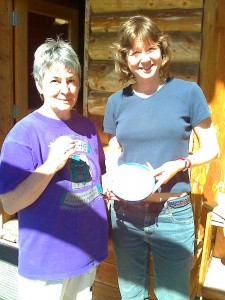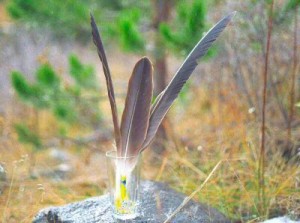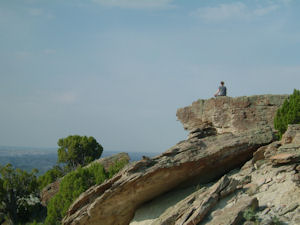Meeting in Circle with the Wilderness Guides Council
Fire is the element of the east, the direction of springtime. When I first sat in circle at the Wilderness Guides Council, on Monday, April 13, I deliberately sat in the east. This is a part of the wheel that I am least comfortable in. Magic happens here, and the unpredictable, for it is in this direction that old forms are broken down so that something new can emerge. It is the direction of creativity, death and rebirth, and has the gift of vision of the eagle flying high in the sky.
I am typically more comfortable in the west, the place of introspection and  darkness. So it felt risky to take my place in the east and own this part of my spirit. There were about 25 guides sitting in the circle, and I listened as they discussed the business of our annual meeting. Things like the budget and who would be carrying on which duties in the year to come. They have a “mask of the ancestors,” and one of the duties is to be the keeper of the mask. It is made out of the pelvic bone of a large animal, and is decorated with feathers and beads. The meeting lasted a long time—about 5 hours—and about 4 hours into it one of the feathers blew off the mask and landed in my lap. It was an orange flicker feather—which I have written about previously in this blog. This was the first magical gift of the east. It seemed like a blessing and confirmation that I am a member of this group. The ancestors confirmed it. And my own heart did too—sitting listening to these people who care about each other, the earth, and the sacred ceremony of the vision fast, I felt my own desire to continue on through time with these people. The gift of the feather confirmed it. I put the feather in my emergency kit, which I always carry with me when I’m out on the land. May it keep all the fasters safe!
darkness. So it felt risky to take my place in the east and own this part of my spirit. There were about 25 guides sitting in the circle, and I listened as they discussed the business of our annual meeting. Things like the budget and who would be carrying on which duties in the year to come. They have a “mask of the ancestors,” and one of the duties is to be the keeper of the mask. It is made out of the pelvic bone of a large animal, and is decorated with feathers and beads. The meeting lasted a long time—about 5 hours—and about 4 hours into it one of the feathers blew off the mask and landed in my lap. It was an orange flicker feather—which I have written about previously in this blog. This was the first magical gift of the east. It seemed like a blessing and confirmation that I am a member of this group. The ancestors confirmed it. And my own heart did too—sitting listening to these people who care about each other, the earth, and the sacred ceremony of the vision fast, I felt my own desire to continue on through time with these people. The gift of the feather confirmed it. I put the feather in my emergency kit, which I always carry with me when I’m out on the land. May it keep all the fasters safe!
The Sweat Lodge
 After the Wilderness Guides Council (of North America) gathering ended, we had about 24 hours to prepare the grounds for the International Wilderness Guides Gathering—a week-long gathering of guides from around the world. I helped out a little, setting up the garbage and recycling bins. But the main thing I had volunteered to do was to help with the campfires, to make sure they were put out safely at the end of the night. But somehow this turned into a new job—helping tend the fire for the women’s sweat lodge, which was going to take place the following Saturday. What an honour! I agreed to help, and thought I’d better get an idea of what was involved. So I went to the first sweat of the IWGG gathering, held on Tuesday, April 14th. This was the second gift of the east.
After the Wilderness Guides Council (of North America) gathering ended, we had about 24 hours to prepare the grounds for the International Wilderness Guides Gathering—a week-long gathering of guides from around the world. I helped out a little, setting up the garbage and recycling bins. But the main thing I had volunteered to do was to help with the campfires, to make sure they were put out safely at the end of the night. But somehow this turned into a new job—helping tend the fire for the women’s sweat lodge, which was going to take place the following Saturday. What an honour! I agreed to help, and thought I’d better get an idea of what was involved. So I went to the first sweat of the IWGG gathering, held on Tuesday, April 14th. This was the second gift of the east.
Meeting the Grandfathers
When I got to the place of the sweat lodge, located under the magnificent oak trees,  beside a creek, I sat down with the others who were waiting, took off my shoes, and nestled my toes into the sand. I had not been in a sweat lodge since about 1993, and I was looking forward to seeing how the heat felt to me now. Munro Sickafoose, the netkeeper for the WGC, was pouring water for the sweat. This meant he was running everything that happened inside the sweat lodge (from the human incarnate end—spirit was really running what happened). A beautiful man named Dirk Johnston was the firekeeper, who ran what happened outside of the sweat, preparing the fire to heat the rocks, and transporting them into the sweat lodge. These heated rocks are called the grandfathers, and the firekeeper communes with these rocks and in a sense is responsible for how the sweat goes. It is a sacred and mysterious duty.
beside a creek, I sat down with the others who were waiting, took off my shoes, and nestled my toes into the sand. I had not been in a sweat lodge since about 1993, and I was looking forward to seeing how the heat felt to me now. Munro Sickafoose, the netkeeper for the WGC, was pouring water for the sweat. This meant he was running everything that happened inside the sweat lodge (from the human incarnate end—spirit was really running what happened). A beautiful man named Dirk Johnston was the firekeeper, who ran what happened outside of the sweat, preparing the fire to heat the rocks, and transporting them into the sweat lodge. These heated rocks are called the grandfathers, and the firekeeper communes with these rocks and in a sense is responsible for how the sweat goes. It is a sacred and mysterious duty.
It turned out that I was the oldest woman at the sweat lodge, so Munro asked me to sit beside him in the lodge, since his wife wasn’t there, and to put cedar on each grandfather stone as it came into the lodge. I felt very honoured to do this. We were taught what to say as we entered the lodge: Aho matakwe-asin! All my relations! After entering we crawled on our hands and knees in a clockwise direction to take our places around the edges of the lodge. There was a pit in the middle, ready to receive the grandfathers. When we were all inside, Munro asked Dirk to bring in 9 grandfathers. Dirk brought in the first rock, glowing red and clearly visible in the darkness of the sweat lodge. He said “Aho, matakwe-asin! Grandfather, come on in!” Munro guided the pitchfork and placed the rock in the pit in the middle. Now it was my job to sprinkle a little bit of dried cedar leaves on the rock. The herb sparkled as it struck the heated red stone, and the scent began to tickle our noses, creating an immediate feeling that something sacred was happening.
 So it went, as Dirk brought each grandfather in. “Aho, matakwe-asin! Grandfather, come on in!” As I sprinkled the herb on each one, I offered a blessing to it. And I fell in love with these glowing grandfather rocks, and with this sacred ceremony from the first peoples of this land.
So it went, as Dirk brought each grandfather in. “Aho, matakwe-asin! Grandfather, come on in!” As I sprinkled the herb on each one, I offered a blessing to it. And I fell in love with these glowing grandfather rocks, and with this sacred ceremony from the first peoples of this land.
Munro told us there would be four rounds. The first round was for calling in the ancestors and spirits. The second round was for praying. The third round was for healing. And the final round was the “going home” round. At the beginning of each round, more rocks would be brought in. During the round, Munro would pour water on the rocks to create steam, increasing the heat in the sweat lodge. To be continued…
 The School of Lost Borders California Fall Vision Fast was amazing! I was an assistant for the 11 fasters and the two incredible guides, Ruth and Larry. Some people marked their passage into adulthood, and others into elderhood. It was such an honour to witness the courage and vulnerability these fasters showed as they faced the unknown and went to fast alone in the desert.
The School of Lost Borders California Fall Vision Fast was amazing! I was an assistant for the 11 fasters and the two incredible guides, Ruth and Larry. Some people marked their passage into adulthood, and others into elderhood. It was such an honour to witness the courage and vulnerability these fasters showed as they faced the unknown and went to fast alone in the desert. in the area around Big Pine, where we camped before and after the solo time. A night run as the moon was coming up out of the White and Inyo Mountains was incredible!
in the area around Big Pine, where we camped before and after the solo time. A night run as the moon was coming up out of the White and Inyo Mountains was incredible!
















 nature. In North America, the plains peoples are the most well-known groups to use the ancient practice of the vision quest. John Murray recounts, in editors Michael Tobias and Georgianne Cowan’s
nature. In North America, the plains peoples are the most well-known groups to use the ancient practice of the vision quest. John Murray recounts, in editors Michael Tobias and Georgianne Cowan’s